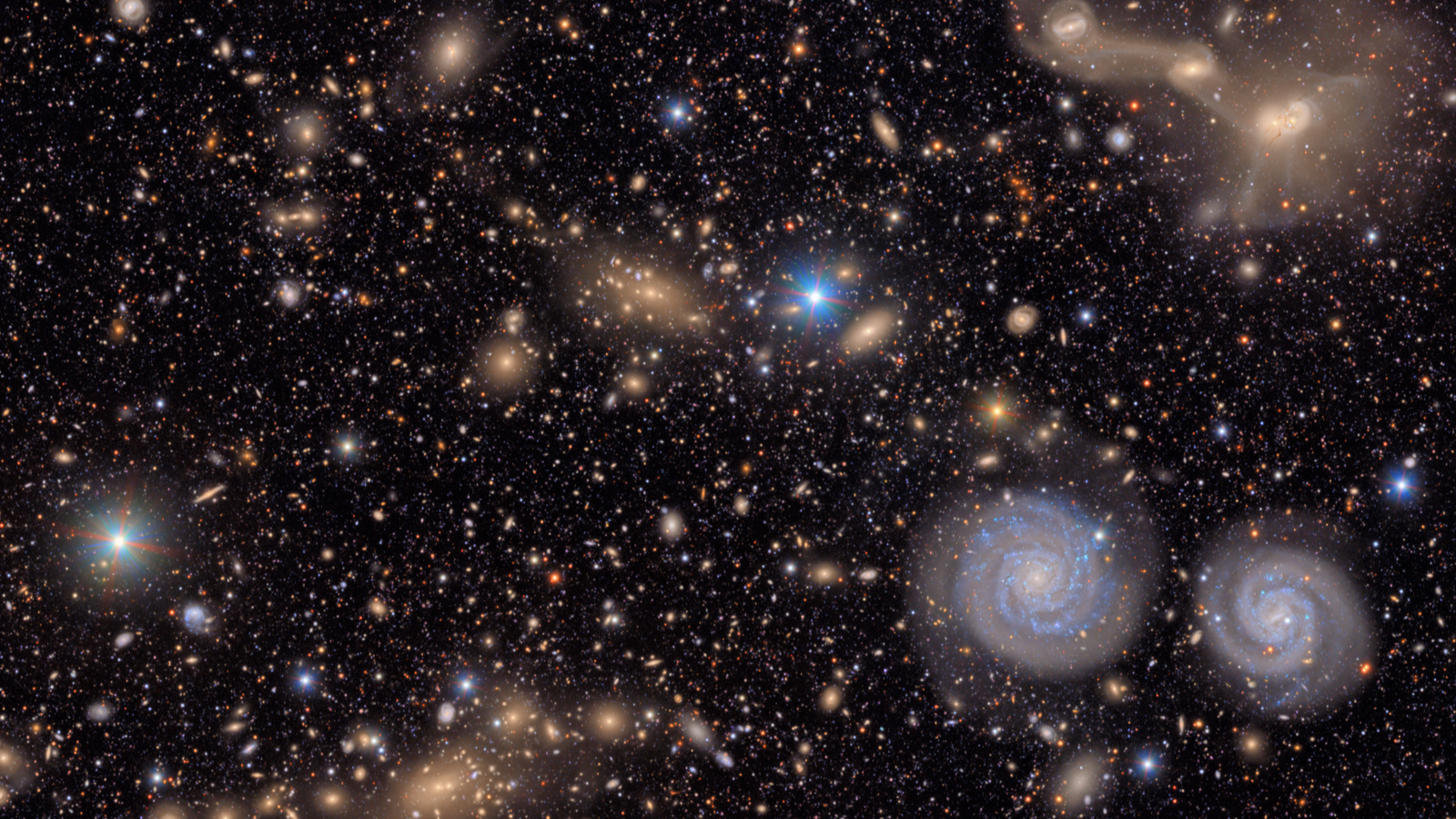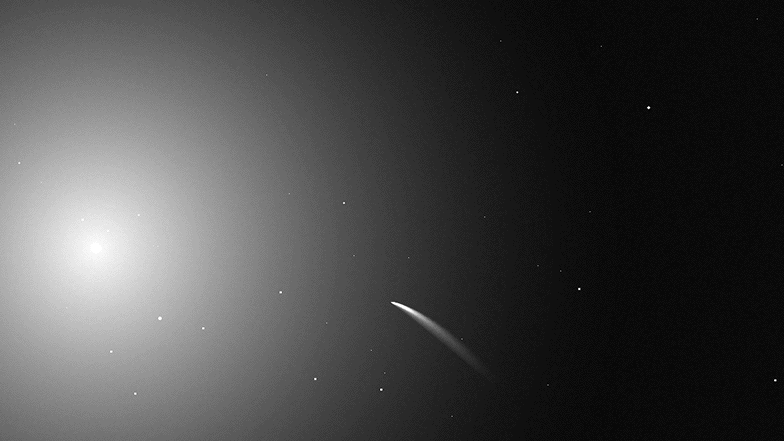
The brightest comet in nearly 20 years — comet G3 ATLAS (C/2024) — is expected to reach its peak brilliance later this week into early next week.
The only question is: "Will you actually be able to see it?"
This celestial paradox belongs to Comet 2024 G3 (ATLAS), which was first sighted on April 5 of last year by the Asteroid Terrestrial-impact Last Alert System (ATLAS) survey, in images obtained with a 0.5-meter (19.7-inch) reflector telescope located in Rio Hurtado, Chile. At the time of discovery, the comet was 407 million miles (655 million km) from Earth and shining at an exceedingly faint magnitude of +19. That's roughly 158,000 times dimmer than the faintest star visible to the naked eye.
Returning after 160 millennia
A preliminary orbit for this comet indicated that it was going to pass exceptionally close — less than 9 million miles (14 million km) from the sun in mid-January 2025; only about one-quarter the distance of Mercury, the closest planet to the sun. However, these initial calculations also suggested that G3 ATLAS was a new comet coming directly from out of the Oort cloud, a vast bubble composed of countless billions of icy objects encircling our solar system, located perhaps 10 trillion miles (16 trillion km) from the sun. Small sun-skirting comets originating from the Oort Cloud, making their first approach to the sun, often disintegrate before reaching perihelion (their closest approach to the sun).
But after G3 ATLAS’s orbit was refined, it was determined that it was actually a dynamically old comet, having made at least one previous close approach to the sun, with an orbital period of roughly 160,000 years. This provided hope that — having survived a prior close encounter with the sun — this comet could survive its impending close brush and possibly put on a bright display after the start of the new year.
Has favored southern skywatchers
Unfortunately, to date, the predicted path of G3 ATLAS has only favored those in the Southern Hemisphere. Practically the entire predicted track of this comet lies through constellations well south of the celestial equator. For those in the Northern Hemisphere, the comet’s path over the past month has taken it through the southern constellations of Lupus and Scorpius, and it currently resides in Sagittarius.
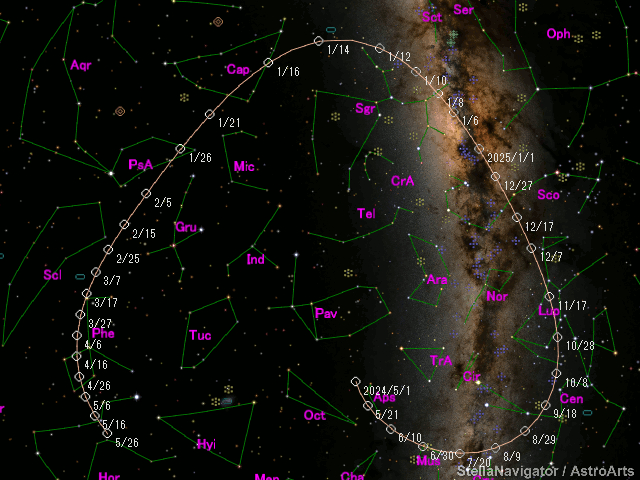
This means that for observers north of the equator, the comet has been positioned much too low on the southeastern horizon and perpetually obscured by the glow of bright morning twilight.
Breaking space news, the latest updates on rocket launches, skywatching events and more!
However, as the comet is now coming down the “home stretch” before it whips around the sun, it has begun to brighten dramatically. For a relatively short time, its path will curve just far enough north to give those north of the equator a fighting chance to glimpse it.
Breakup avoided?
Recent observations collected on the Comet Observation database (COBS) suggest that, on Jan. 2, 2025, G3 ATLAS experienced a sudden outburst, showing a nearly four-fold increase in apparent brightness. However, John Bortle, a well-known and highly reputable comet observer, expressed ambivalence about this unexpected brightness spike. In an email to Space.com, Bortle noted:
"The apparent instability exhibited in the recent magnitude increase usually can be interpreted as a bad sign that the comet is showing evidence of breaking up, but some other unusual features that have been reported such as the 'shadow of the nucleus' is a classic feature of any large comet near perihelion, and not a sign of disruption."
Still, Bortle is uncertain about G3 ATLAS's ultimate fate, "I think chances of its survival are about 50:50," Bortle noted.
Another noted comet observer, Nick James of the British Astronomical Association, also commented on the comet’s latest surge in brightness.
"The sudden jump in brightness was significant. This could have been an early sign of disintegration, but since then, the comet is still brightening. It looks as if this outburst has not been fatal," James told Spaceweather.com.
How bright will it be?
G3 ATLAS will always be positioned very near the sun, raising the main question: Will it get bright enough to be readily seen against the twilight sky? Unfortunately, that is difficult to predict. Like snowflakes, no two comets are exactly alike. Astronomers have developed mathematical equations to forecast brightness, but it’s especially challenging for new or long-period comets like G3 ATLAS, where no prior visits are recorded.
On January 4, Daniel Green of the Central Bureau for Astronomical Telegrams in Cambridge, Massachusetts, issued an updated circular on G3 ATLAS, forecasting its brightness based on its development in recent weeks.
The comet is expected to reach perihelion on Jan. 13 at 10:17 Universal Time (UT), at a distance of 8,695,216 miles (13,993,594 km) from the sun. Later that same day, it will come closest to Earth at a distance of 87.1 million miles (140.1 million km).
Green predicts the comet could reach a maximum magnitude of -3.2, placing it between the brightness of Jupiter and Venus, which are prominent in our evening sky. "The comet will be close to the sun when brightest, but it’s becoming difficult now even for Southern Hemisphere observers to see," Green told Space.com. "It’s really hard to call these comets when close to the sun like this, in terms of visibility."
Indeed, although Green's forecast suggests G3 ATLAS will get quite brilliant, its close proximity to the sun makes it rather debatable as to whether a casual observer will be able to pick it out against the bright twilight sky. If the comet were to become brighter, however, it might be easier to see.
For that to happen, we would need to consider forward scattering.
Forward scattering: The 'dusty windshield effect'
Forward scattering in comets is a phenomenon that occurs when sunlight is scattered by dust particles in a comet's tail and coma, causing the comet to appear brighter. This happens when a comet is between the Earth and the sun, or when the Earth-comet-sun angle is high. Forward scattering can make a comet appear significantly brighter, especially when the phase angle is high. It is similar to the effect of driving toward the sun with a dusty windshield.
Forward scattering in comets occurs when sunlight is scattered by dust particles in a comet’s tail and coma, causing the comet to appear brighter. This phenomenon happens when a comet is between the Earth and the sun, or when the Earth-comet-sun angle is high. Forward scattering can significantly enhance a comet’s brightness, especially when the phase angle (Earth-comet-sun angle) is high. It’s similar to the effect of driving toward the sun with a dusty windshield.
In the case of G3 ATLAS, its phase angle is predicted to reach a maximum of 115 degrees late on Jan. 13. How much this will enhance the comet’s brightness is debatable. From my own calculations, I estimate the comet could brighten to a magnitude of -4, putting it on par with Venus. However, others predict an even greater enhancement. The most extreme prediction comes from Dutch amateur astronomer Gideon van Buitenen, who forecasts a peak magnitude of -6, nearly three times brighter than Venus!
Still, the odds of this extreme brightening happening are low.
When to look for comet G3 ATLAS

Keep up to date with what you can see in the sky tonight with our live night sky blog!
As of now, there appears to be a three-day window — Jan. 12 through 14 — for observers in the Northern Hemisphere to glimpse G3 ATLAS.
Your first opportunity will come early on Jan. 12. From mid-northern latitudes, the comet will rise about 35 minutes before sunrise and will be positioned 5 degrees directly above the sun at local sunrise. So, beginning about 25 minutes before sunrise, slowly scan/sweep along the east-southeast horizon with binoculars to try and sight the comet.
On the evening of Jan.14 , the comet will set 35 minutes after the sun and at local sunset will be positioned about 7 degrees almost directly above the sun. So, beginning about 10 minutes after sunset, slowly scan/sweep along the west-southwest horizon with binoculars to try and sight the comet.
How to see comet G3 ATLAS
- Make sure that you have access to a clear, unobstructed view toward the east-southeast and west-southwest horizons. The comet will be very close — only a few degrees — above the east-southeast horizon on Sunday morning and a similar distance above the west-southwest horizon on Tuesday evening. If you can get to a shoreline where you'll have a flat sea horizon, or have access to a tall hill where you'll be above any surrounding obstructions (like tall trees or buildings) that will give you a distinct advantage. Additionally, you’ll need to hope for clear skies without low-lying clouds near the horizon.
- A good pair of binoculars is essential. 7x50 binoculars are recommended, but if you use a larger pair, such as 11x80 binoculars, mounting them on a sturdy tripod will provide even better results.
- If visible, G3 ATLAS will resemble a bright star, shining with a whitish or golden color. If a tail is visible, it will likely appear short or stubby and point almost straight up, possibly tilted slightly to the right. After spotting it with binoculars, try to see it with your naked eye. The brighter the comet becomes, the more likely you’ll succeed.
To estimate angular degrees, remember that your clenched fist at arm’s length measures about 10 degrees. So, 5 degrees would be about half a fist.
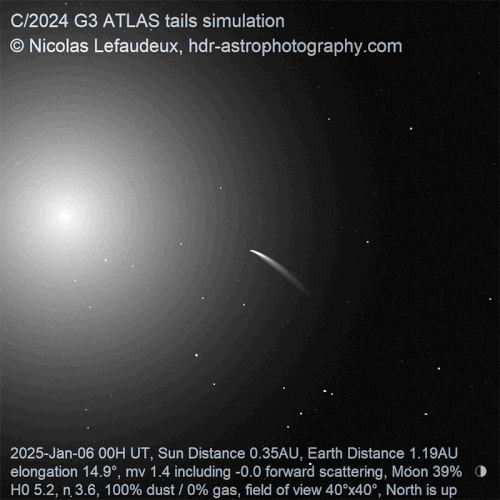
Could G3 ATLAS be visible during the day?
Monday, Jan. 13 is the day when the comet will theoretically be at its brightest. As we have already noted, estimates for how bright it will get, range widely from magnitude -3 to -6. If G3 ATLAS were to get to magnitude -4 or brighter, then — theoretically — that could make the comet bright enough to glimpse in the daytime.
CAUTION! With the comet passing just 5 degrees above the sun, attempting a daytime sighting is inherently dangerous. Viewing the comet itself poses no harm, but staring at the sun — even briefly — can cause severe retinal damage without any pain. This damage can lead to permanent blindness.
And with the comet passing so close to the sun, do not try for a daytime sighting by scanning for it with binoculars!
The safest way to watch
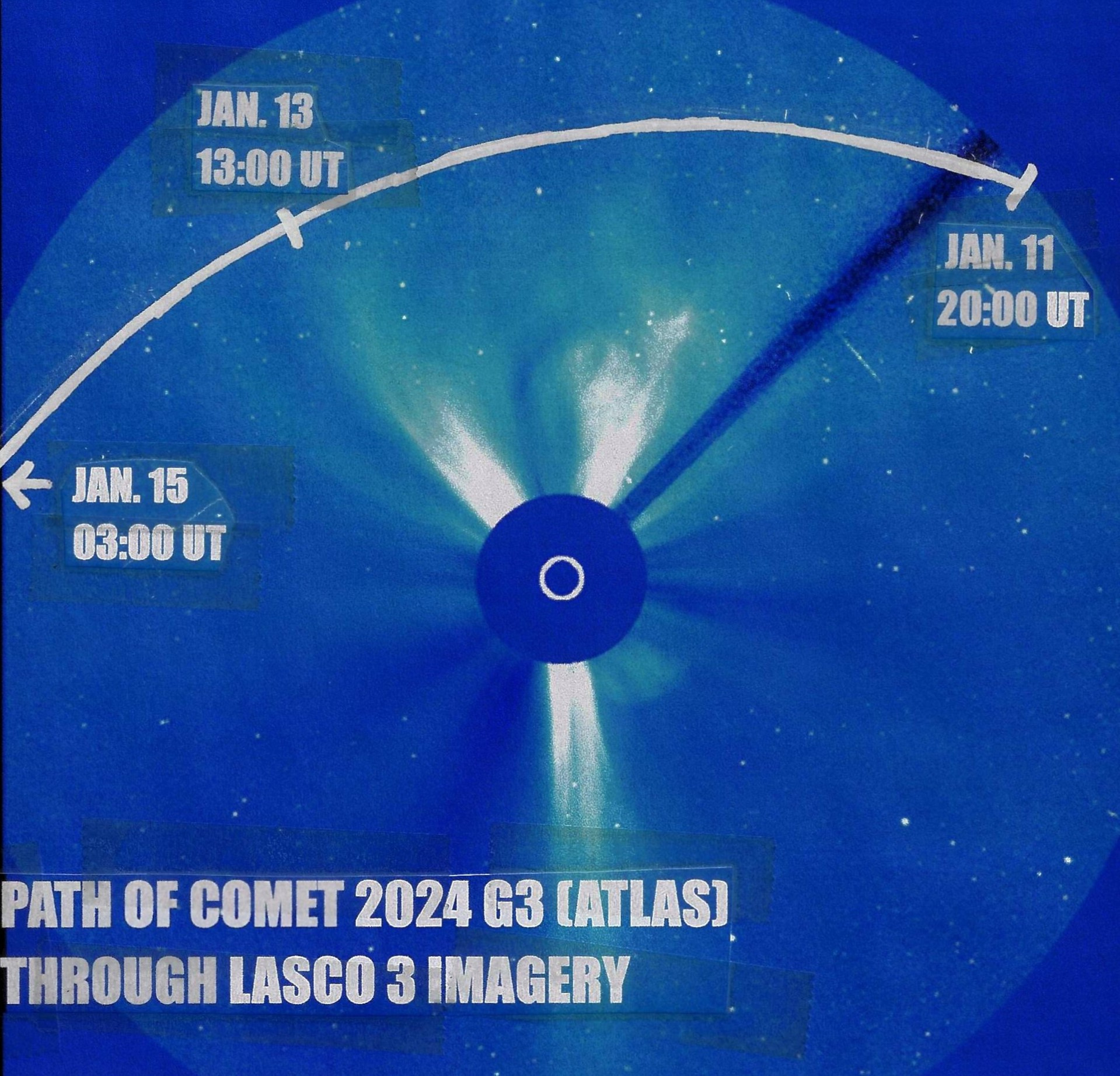
By far the safest way to watch the comet's close brush with the sun is to view it on your computer screen courtesy of the Solar and Heliospheric Observatory ("SOHO"). Astronomers hope to get spectacular views of the comet by utilizing SOHO's LASCO (Large Angle and Spectrometric Coronagraph Experiment) C3 camera and accessing either near-live images or videos that span the past 24 hours.
Last October, the public was captivated when SOHO captured Comet Tsuchinshan-ATLAS sweeping close to the sun. Since its launch in 1995, SOHO has discovered over 5,000 comets using LASCO C3 imagery.
Comet G3 ATLAS will be within range of the LASCO C3 imagery from Jan. 11 at 20:00 UT (3:00 p.m. EST) through Jan. 15 at 03:00 UT (10:00 p.m. EST on Jan. 14). It will appear to pass closest to the sun — a scant 4.9-degrees from its center — on Jan.y 13 at 13:00 UT (8:00 a.m. EST).
If there are any significant updates, we will post them here at Space.com, so stay tuned!
Joe Rao serves as an instructor and guest lecturer at New York's Hayden Planetarium. He writes about astronomy for Natural History magazine, the Farmers' Almanac and other publications. Follow us on Twitter @Spacedotcom and on Facebook.
Join our Space Forums to keep talking space on the latest missions, night sky and more! And if you have a news tip, correction or comment, let us know at: community@space.com.

Joe Rao is Space.com's skywatching columnist, as well as a veteran meteorologist and eclipse chaser who also serves as an instructor and guest lecturer at New York's Hayden Planetarium. He writes about astronomy for Natural History magazine, Sky & Telescope and other publications. Joe is an 8-time Emmy-nominated meteorologist who served the Putnam Valley region of New York for over 21 years. You can find him on Twitter and YouTube tracking lunar and solar eclipses, meteor showers and more. To find out Joe's latest project, visit him on Twitter.
-
sargamites I observed Comet C/2024 G3 ATLAS on January 4, 5 and 9, from near Tucson AZ, around 0650 MST on all days, using Canon 10x42 IS image Stabilized binoculars.Reply
The comet has brightened significantly and was fairly easy to find this morning (9 Jan) by using Mercury in combination with a planetarium program (ie, SkySafari) to estimate it's rising azimuth.
A short tail of perhaps ⅓ - ½⁰ was visible today. Unable so far to see it without optical aid. -
sargamites Photos showing Comet G3 ATLAS, taken on January 5 and 9, can be seen at this Dropbox link:Reply
https://www.dropbox.com/scl/fo/qbrp7wz9ih2rrzb8iv6hp/ANe1v6ZFWgoYcjkwQ04eGzw?rlkey=i7fd66318bik3dw7q6g1rkmaz&st=c5s01ena&dl=0
The photos are representative of the view I had thru 10x42 binoculars. They were taken with 80mm APO refractor and Canon 6D on a fixed tripod.
If you are able to see this comet, I'd like to hear about your observations! -
sargamites Addendum to last post: download photos from Dropbox for best view; Web view versions appear to be compressed.Reply -
sargamites Friday January 10 @ 0645 MST (1345 UTC) observation:Reply
Comet much brighter, seen naked eye with certainty and difficulty. Easy in 10x42 binoculars in very bright background sky. Approx 0.5⁰ tail. Visible in binoculars until 0712 MST, which was 14 minutes before local sunrise.
